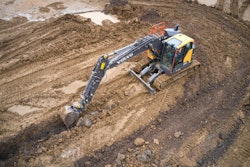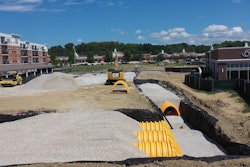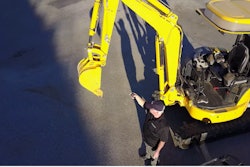
While Trimble, Leica and Topcon own much of the market for equipment automation, Sodex, Unicontrol and Built Robotics are offering novel or more affordable technologies that may either push the boundaries of construction equipment autonomy or enlarge the addressable market for equipment automation.
As more government infrastructure projects specifically call for construction equipment automation, contractors involved in other types of work are also attracted to the efficiencies delivered by technology that makes earthmoving and other equipment easier to use, captures production data or increases safety.
In some cases, these technologies are fresh off the drawing board, still nailing down distribution in the United States, or are just coming to market. But today and increasingly in the months and years ahead, contractors interested in equipment automation will have more choices with a broader swath of capabilities than they do today.
 Sodex’s technology automates the surveying, documentation, and billing of excavated material on construction sites through continuous measurement of the three-dimensional terrain.Sodex Innovations
Sodex’s technology automates the surveying, documentation, and billing of excavated material on construction sites through continuous measurement of the three-dimensional terrain.Sodex Innovations
Sodex Excavator Automated Measurement
An Austrian company, Sodex Innovations, came to market in March 2022 with an automated measurement tool targeted at small excavators. The company’s technology automates the surveying, documentation, and billing of excavated material on construction sites through continuous measurement of the three-dimensional terrain. To accomplish this, Sodex combines a camera and laser technology with several sensors to record and measure the environment in the excavator's working area, geo-referencing all measured points through a GNSS/GPS system to determine their absolute position. This creates a digital record of volume of material removed or inserted in a format that other software applications can use for billing and real-time analysis.
The SDX-4DVision is designed as a retrofitting solution that can be directly upgraded to any excavator regardless of brand, size or age without major conversion work. Contractors can integrate the SDX-4D Vision System with conventional GNSS systems, such as those from Leica Geosystems to automate production recording and billing.
According to Sodex Research and Development Hardware Engineer Markus Haftel, the product is in distribution in Europe but Sodex is looking for distributors in North America, including rental organizations that can retrofit their fleets as a differentiator in the market.
“If a distributor already has a fleet of excavators, they can mount our system on it and rent them out,” Haftel said. “It is also possible the distributor can sell our product independently to the fleet owner and mount it into the excavator. But in the rental channel we anticipate they will be renting the excavator with our system installed. Our current distributors focus on small excavators between 2.5 and 15 tons. Sometimes we can retrofit larger excavators, but our main use case is in landscaping and sometimes in quarries.”
Small but Growing
Sodex, founded in 2021, employed about a dozen at the time of ForConstructionPros’ discovery call with them. The firm at that point was primarily focused on formalizing its European distribution through a team of partner organizations and then establishing a foothold in North America. In both geographies, there ideal customer is the same.
“We are looking for customers who are medium-sized excavation companies interested in retrofitting their excavators,” Haftel said.
Installation, according to Haftel, takes about 10 hours of shop time.
“You need not that high a level of skill, but some basic mechanical skills and skills in electronics,” Haftel said. “You have to mount the contour cabinets to ensure everything is connected correctly—not just physical mounting of some sensors
Many of the new companies in construction equipment automation and technology are venture-funded, which can make a company vulnerable to investors’ wish for a liquidity event at some point. Sodex benefits however from two principals who are invested long term—both of whom have capital from the sale of the Austrian Shpock resale app. Sodex has also received investment from the Austria Wirtschaftsservice (AWS), through the AWS Capital Initiative. This long-term funding means should provide Sodex with added stability required to scale its operation.
Sodex Technology Stack
While technology is coming to market to automate functions of excavator operation, Sodex only focuses on data capture, measuring the dimensions of surrounding material in the area around the excavator and detailing the volume of material moved from one place to the other.
“Our users get a detailed map afterwords of the surrounding area, including scans by time. The camera can see below grade, and based on the changing dimensions, can calculate the volume of earth moved. The technology can perform a billing calculation based on this data, based on the volume excavated, along with documentation of the work.”
A machine operator would still need to provide documentation on the type of earth moved—gravel, sand, topsoil or other material. But the technology eliminates the need for surveying for invoicing and harnesses automated data captured on productivity to streamline the billing process further.
What Sodex is offering is a licensed software and hardware product, centered around an 800,000 points-per-second laser scanner capable of creating a very detailed and continuous map of the ground surrounded by the excavator.
“The worker inside will still dig, and can focus on his or her digging work and not the billing or surveying or other things,” Haftel said. “They don’t have to worry about the documentation of the work.”
Currently, the Sodex technology does not communicate with the cloud, connecting instead to a tablet computer in the cab through Bluetooth.
“We are developing a cloud solution so you can have an app and look up the data on the excavator,” Haftel said. “Right now, everything is stored locally, and just a fraction will be sent frequently to the connected computer. Not all the data is sent. Our sensors are directly connected to the control cabinet, and the tablet is connected by Bluetooth.
Features on the product roadmap include additional integrations with third party software that can consume the data and AI tools for differentiating various types of subgrades. In time, more and more data will be exposed and make consumable by external systems dedicated to tracking productivity, including enterprise resource planning (ERP) software.
 The automation delivered by an excavator equipped with Built Robotics technology first of all helps the robot know what it needs to produce, so the technology enables ingestion of a design, along with GPS coordinates so the excavator can know its position and localize on site.Built Robotics
The automation delivered by an excavator equipped with Built Robotics technology first of all helps the robot know what it needs to produce, so the technology enables ingestion of a design, along with GPS coordinates so the excavator can know its position and localize on site.Built Robotics
Built Robotics Automated Excavation
Funded by a who’s who of construction venture capitalists, San Francisco-based Built Robotics has aftermarket solutions to fully automate 15- to 60-ton excavators, and in April of 2022 secured an additional $64 million in Series C funding in a round lead by Tiger Global. The company in 2019 announced a partnership with Sunstate Equipment designed to funnel automated light excavators into the rental channel.
But in a briefing call with ForConstructionPros in March of 2022, Built Robotics Vice President Guarav Kikani suggested equipment in the rental channel seemed a ways off, despite a partnership with a major rental industry player. Instead, the company seems to be pursuing trenching on large infrastructure projects including solar farms.
“Today, most of our work is direct with the customers,” Kikani said. “We are working with large contractors who run a lot of equipment and have large fleets. That has been the most expedient way to go to market and to build the operational playbook. As we grow, our partnership with Sunstate Equipment and other equipment rental houses will become a critical part of our strategy to scale.”
While eventually automation technology from Built Robotics could be offered by OEMs, the focus into the foreseeable future will be to aftermarket installation due to the long timeframe it takes for equipment already in the field to turn over. The tech will currently automate both electronically and pilot hydraulic systems. But since electronic controls are standard on more current equipment since about 2018, and since that is the direction the industry is going, installation will get easier and easier going forward.”
Fueled by venture capital, Built Robotics has built a team of about 35 people in San Francisco and Australia. About a fifth of that staff is devoted to customer success, indicating a growing ability to ensure customers realize value on an investment in Built Robotics technologies. Another 50 to 60 percent of the team is software and robotics engineers—creating new features and tools based on feedback from the field. That team will work initially with major engineer, procure, construct (EPC) contractors and smaller contractors focused on utilities and trenching—anyone, according to Kikani, focused on digging trenches with excavators.
“We are also seeing interest in our tech outside of the contractor community,” Kikani said. “Developers are interested in this tech—and we could see more of a mandate for their contractors to use automation like this. But when we think longer term, I see us working directly with rental companies and OEMs to integrate our automation technologies with equipment.”
Built Robotics Tech Stack
The company has raised $112 million in venture funding to date, and according to Kikani, this is necessary to fuel the company’s ongoing research and development efforts. This in turn will pay dividends to investors as the technology matures, becoming more useful in redevelopment and urban environments.
“First—even if we just do greenfield projects like we are now, that is still a massive market,” Kikani said. “Our focus now is getting the technology out there, into customer hands, and then building that operational playbook. There is a lot of work to be done. We do intend to handle more corner cases and urban environments, but for now we are pursuing the safest and more prudent projects. This is not just a science experiment—we have been driving customer value since day one. So yes, we are doing trenches now, but getting into site-level orchestration of job sites in the future.”
The automation delivered by an excavator equipped with Built Robotics technology first of all helps the robot know what it needs to produce, so the technology enables ingestion of a design, along with GPS coordinates so the excavator can know its position and localize on site. A series of sensors collect information on its orientation in space including tilt and velocity.
“The excavator takes all of these data points and uses them to pinpoint the end effector—the tip of the bucket teeth—by knowing exactly where it is digging, comparing it to what it knows about the site,” Kikani said. “It can turn the existing world into the design it has been given.”
An edge computing device on the excavator runs the algorithms that direct production, collecting insight from the environment including resistance from the ground and track slip as it goes that results in modified tactics and approaches. Built Robotics also includes camera-based machine vision, used primarily for pedestrian detection. High-fidelity radar, meanwhile, helps the excavator avoid buried infrastructure.
Roadmap items include capabilities for backfill and compaction and loading trucks—which has been a challenge for researchers working to help an automated wheel loader identify the truck where material is to be deposited, resulting in efforts to teach the machine learning algorithm using videos of scale models.
“There are some sophisticated yet reliable ways to do that,” Kikani said. “I would argue one of the harder things to do is not recognizing the hopper but to see the material to scoop. Spoil piles change as you move them. That requires a lot of sophistication.”
Also on the roadmap according to Kikani are capabilities for pile driving—in demand due to the construction of solar power infrastructure, and grading.
Moving Towards Commercialization
While still addressing specific and repetitive use cases, Built Robotics is securing sales and shipping product. They will not disclose unit numbers sold but are according to Kikani finding some commercial success. And at the time of Kikani’s debriefing call with ForConstructionPros in March, hardware was available and installations were scheduling about a week out.
“Last year was huge in that we did ship a lot more units and handed them off to customers,” Kikani said. “Now, it is about getting more numbers out there.”
To help the company scale from a sales perspective, and to streamline installations, Built Robotics is assembling a channel and service partnerships.
“Installation, if it is customer owned, takes one to two hours to do the hardware and another hour to do calibration,” Kikani said. “Today, Built Robotics does the installation. Over time, we will provide training and certification to make sure customers and workers can successfully operate automated equipment. We are partnered with International Union of Operating Engineers to train their members on how to run robots in the field. We have a couple already certified.”
In the meantime though, the Built Robotics team is on the road doing installations and educating end users.
“Today, we provide high touch, through more of a partnership model with our customers,” Kikani said. “Long term, we are building an ecosystem and have talked with dealers and third party installers. But a lot of our customers will in-house the installation. It is worth noting that we try to rely more on the software as opposed to hardware, and we have pushed sophistication to the software side—we can push an update over the air to the entire fleet, just like Tesla pushes updates.”
Room for Growth
Some end customers who have experienced Built Robotics technology in the field report that the excavators still require a good deal of oversight and stop frequently due to conditions in the site. The robots also exclusively rely on cell signal for communication, apart from a USB port for updates and loading models. In time, other communication modalities including satellite could be added to the product.
“For updates, we can do it the old-fashioned way with a USB stick,” Kikani said. “Connectivity is very helpful for streaming video feeds and other nice features—like pushing data to the cloud. But all of the computation happens on the edge and on these robots—that is where the data hungry stuff happens.”
 Founded in 2018 in Odense, Syddanmark, Norway and with boots on the ground in North America as of early 2022, Unicontrol has launched Unicontrol3D, a straightforward guide-on-the-side interactive tool to make excavation easier.Unicontrol
Founded in 2018 in Odense, Syddanmark, Norway and with boots on the ground in North America as of early 2022, Unicontrol has launched Unicontrol3D, a straightforward guide-on-the-side interactive tool to make excavation easier.Unicontrol
Unicontrol Machine Guidance
Founded in 2018 in Odense, Syddanmark, Norway and with boots on the ground in North America as of early 2022, Unicontrol has launched Unicontrol3D, a straightforward guide-on-the-side interactive tool to make excavation easier. In a march 2022 briefing with ForConstructionPros, Unicontrol Chief Commercial Officer Ehsanullah Ekhlas described how the company is offering a software-centric approach that makes using excavators, wheel loaders and backhoes more intuitive, putting technology in the hands of even the smallest contractor and potentially making rental equipment easier to use.
Affordable Excavator Technology
While dominant excavator technologies focus on automating operation of components including the arm, dipper arm, bucket cylinder and that swing gear that controls the turret—plus forward motion of the vehicle itself—Unicontrol is focused on improving operator effectiveness and efficiency, eliminating the need for site surveyors because the operator can see the project plan superimposed on reality on a screen in the cab. The Unicontrol3D system includes sensors for the boom, dipper arm, swing arm and on the bucket to sense tilt. Also included is a GPS receiver and control box, GPS antennae and tablet display. Operators can share design files between multiple machines equipped with Unicontrol3D, orient and execute a design with GPS guidance or operate in 2D mode when not connected to GPS by zeroing out the height of the bucket each time the machine is moved.
Unicontrol3D is a product for companies or individual owner-operators who want the ability to dig more effectively and collect productivity information for billing without plunking down the pile of money required for automation.
“The contractor is asking for help because they have to document everything they are doing,” Ekhlas said. “Some need GPS to get the job. For them, getting into a bigger brand has been quite expensive and quite complicated. They may be afraid of machine control.”
While Unicontrol does not automate production, it does automate data collection for production reporting and as-builts. This, along with eliminating the cost of a third-party surveyor or flag man, makes for rapid ROI.
“We help operators avoid rework, avoid surveyors telling you where to dig, all in machine,” Ekhlas said. “This is a tech they know they need to use. If they don’t do it, they will not survive.”
While Unicontrol does not automate the machine itself, it is a lot more affordable than applications that do, coming in at around $3,000 per machine including installation
“At the moment we are only guided—we are not in the automation space,” Ekhlas said. “We show where to dig and how deep, but the ability to control the machine is on our roadmap. But a lot of operators are not happy with those construction equipment automation systems—they are working way too slowly for them. The biggest difference is simplicity.”
Unicontrol is also open to multiple non-proprietary file types when it comes to project models, including XML and DXF files.
Fast-Growing Startup
The company employs about 40 and had its technology on about 700 pieces of equipment at the time of the briefing and is setting up distribution in North America. The company has 11 employees dedicated to customer success, and according to Ekhlas, there is a reason such a small complement can support so many systems in the field.
“The way we go about doing this is rather different,” Ekhlas said. “But we have built it differently—we see ourselves essentially as a software company, and most of our developers are in fact also somewhat customer facing. We go to market direct only in Denmark, and in the rest of the world rely on distributors to do the first and second level of support, and we train them. That is why there are not more customer success people. Our product does not require much, and then we go to market with others who sell and work directly with the customer.”
“Our system is built by equipment users for equipment users,” Ekhlas said. “Other systems are built by surveyors for surveyors. When we started, we reached out to equipment operators at all levels and got feedback and implemented that within short time cycles—we believe that is the right way to go.”
The technology offered by Unicontrol is designed precisely to make operating easier—not by automating the productive capacity of the equipment but by enabling the operator to see what they are doing when the machine conforms to the BIM model, improving quality and consistency.
Unicontrol also should prove economically sustainable as they are already profitable and have internal funding
“We have three founders who got some soft money and then we brought two business angels onboard in April of 2020,” Ekhlas said. “And then we have another element that will help us—our technology is designed for mass customization. The system for US is not the same as what we may sell in Australia, Poland or Denmark—we have a lot of features that distributors choose that determine how the system will operate—what screens you are seeing and what functionality is available.”
The tablet application is updated from a cloud application running on AWS.
“At the start, we were updating every two weeks,” Ekhlas said. “Now, we are on a cadence of every two to three months. The bigger we get, the more features that will change, leading to more frequent updates.”
The cloud application also enables the operator to upload projects, and the computer guidance technology then assists the user in executing against that project plan or model. There is also a diagnostic tool that enables the Unicontrol support team to see operational data from the last 30 days—a valuable trouble shooting tool.
“Based on that, can see if there is a cable loose, or what the root of a problem is,” Ekhlas said. “About 95 percent of challenges are solved from the office.”
To be clear, Unicontrol3D includes both hardware that collects data from the equipment and the software, which is their main focus, but they source the hardware components. And the fact that the hardware is not proprietary may help them deliver products during a time in history characterized by supply chain constraints.
“We are not manufacturing,” Ekhlas said. “We are an open system. So while we deliver the full system, we are working with those that deliver the hardware. What that means is that we can deliver—more so than some other people. With the standard components, you get the luxury of double or triple suppliers of the same part, which makes it more available in the market.”
Unicontrol Roadmap
While the primary goal right now is for Unicontrol to penetrate the North American market, they also have additional solutions waiting in the wings.
“We are trying to work on different solutions and have a solution in addition to the excavator and wheel loader. We have a handheld GPS solution coming to expand our product portfolio. We know that there is a large market for dozers in the United States, and we are working on that as well as a skid steer and a grader solution.”



















